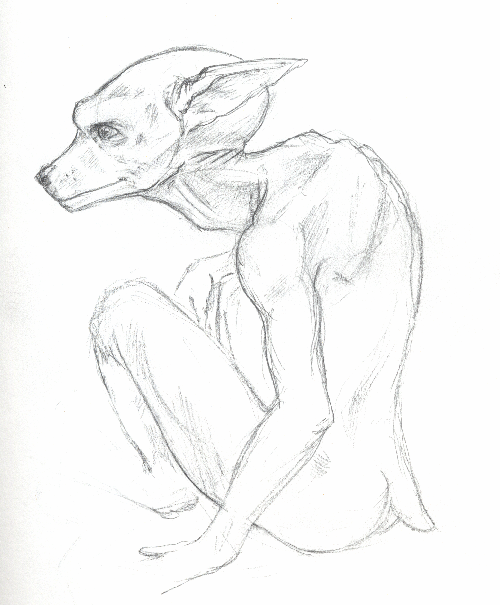
GikDaa Concept Sketch
The GikDaa are, to human eyes, a species of childlike, hyperactive, genius problem solvers. They have an innate understanding of how the physical world operates and they tend to find the most efficient possible processes for any given problem.
The NorAellians describe them as infinitely fascinated by technology and never content until they could understand not just the 'how' of something, but the 'why'. These two traits often lead to confusion when a GikDaa will rewire or reorganize something in a human space simply because, to them, their way is far more efficient, even if this efficiency makes little to no sense to those who would need to utilize it.
¶ History
¶ Biology
GikDaa are a near-mammal species similar to marsupials. They are small, mostly hairless, bipedal, and vaguely humanoid. They are almost universally polyglots and can pick up new languages with ease. Of all of the known species, the GikDaa have the shortest lifespans. Even with modern medical advancements, their average lifespan is barely 70 years.
Owing to their sub-terrainian evolution, GikDaa have extremely poor eyesight. Their scent, sound, and - maybe most importantly - touch senses developed to compensate. This has resulted in their elongated snouts, ears, and fingers. As well, they have developed microscopinc suckers along their fingers and palms. These structures serve multiple purposes: they are touch organs adding to the sensativity of their sense of touch, they provide increased dexterity, and as outlined below they aid in the reproductive process.
¶ Reproduction
As a species, GikDaa are hermaphroditic. During mating, their reproductive organs may act as both 'male' and 'female' depending on their particular alignment in the moment. However, this act of mating is not, in and of itself, enough for reproduction to occur.
The GikDaa possess a secondary system of organs connected to the primary reproductive system. This secondary system begins with a structure contained in their philangial suckers. When a GikDaa touches a person, this structure scrapes off a genetic sample. This sample is sent into an organ which contains cells that operate similarly to the bacterial CRISPR-Cas9 system. Somehow, this organ can extract and preserve sections of genetic code.
When a GikDaa is prepared for reproduction, this CRISPR organ will release a majority of it's preserved genes, passing them down to another organ connected to the GikDaa's womb, where an egg equivalent will be exposed to these genes. This organ will work to combine the genetic samples into the gene sequence of the egg until a new, viable genetic sequence is formed.
At this point, the organ will release the egg into the womb, where an enzyme activates cell division. Unlike humanity, a GikDaa egg does not need to attach to the wall to divide successfully. Gestation takes roughly four months to complete before birth, when their young are transferred to an abdominal pouch for a further four months.
¶ Focus
The GikDaa are instinctive Focus users. Their philangial sucker structures also act as the main point of their Focus use. When a GikDaa touches a person or object, their will aides in their comprehension of whomever or whatever they are touching.
This has made the GikDaa a very touch-oriented species, as their best method of understanding the world around them is through this Focus-enhanced sense.
This is a purely instinctual, or autonomic, thing. Even once the GikDaa learn about Focus, this is not a function that they can control. Early on, when the NorAellian's first introduced the two species, this was what led to tension between Lyndri and GikDaa, as Focus-sensative Lyndri were deeply repulsed by the autonomic Focus use of the GikDaa.
¶ Society
GikDaa society rarely develop around family groups. Instead, they develop communities of interest and, as a society, they are not only fine when a member wishes to leave one community for another, they encourage this.
To the GikDaa, they know they have a limited lifespan and as a result, they have embraced a societal drive to experience as much as they can. To most other species, this adds to the childlike impression of the GikDaa.
¶ Widdershins
Prior to being introduced to humanity, the GikDaa did not have a word for those who struggled to find a community to belong to. In one of the earliest interactions with a human, a GikDaa was attempting to explain this and the human linguist replied that "it sounds like these GikDaa go widdershins for a bit." This term was practically (and literally if you read the actual account) pounced on by the GikDaa.
Now, instead of saying "we recognize that you do not feel a bond to us in this community and wish to go find one you can bond with. We will miss your presence but we want you to find your happiness more. Go and find your people" they will simply see that a person has gone Widdershins and any GikDaa who hears this will understand.
¶ Plot
The GikDaa have become a bigger part of the universe. Stay tuned.
¶ Behind the Scenes
From Case (pre 6/25):
Originally, I'd thought of the GikDaa as the personification of 'gremlins'. The idea that most ships would have some, unbidden, like rats, that could come in, in a pinch, amused me. I decided to drop them and focus on a few races and really flesh them out, but I couldn't get rid of the GikDaa entirely. So, I made them a dead race, and an interesting point in NorAellian history.
From Matt (6/25):
Surprise! We love these little gremlins so we expanded their role, their history, their society, and kind of everything. Enjoy!